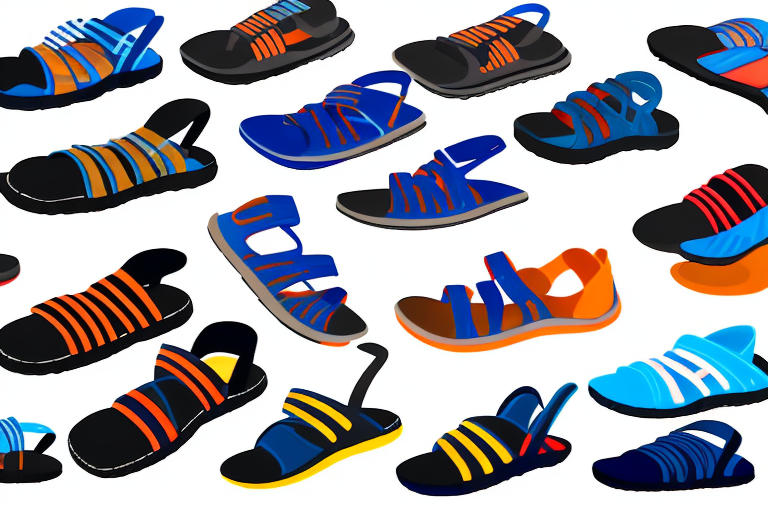When it comes to footwear for the summer months, there’s a lot of choice out there. This can make it difficult to decide which style is right for you. Two of the most popular choices are wedge sandals and flatform sandals – but how do they compare? In this guide, we’ll take a look at the key differences between wedge sandals vs flatform sandals, explore the pros and cons of both, and discuss when and how to wear them. Finally, we’ll wrap up with some advice on where to buy quality wedge and flatform sandals. Read on to find out which style is right for you!
What Are Wedge Sandals?
Wedge sandals are a style of footwear that combines a chunky heel with a platform sole. The heel portion has a wedge shape, rising from the back of the sole and tapering down towards the toe. Wedge sandals usually have a thick, tough sole and straps around the foot. This makes them a comfortable and supportive option, making them suitable for all-day or long-distance walking.
What Are Flatform Sandals?
Flatform sandals are a variation on the classic platform sandal. They feature a thick, tall sole and usually have straps around the foot as well. The difference is that whereas wedge sandals have a curved heel, flatform sandals have a flat platform. This makes them much more comfortable for walking and standing than wedge sandals.
Key Differences Between Wedge Sandals and Flatform Sandals
The key difference between wedge sandals and flatform sandals lies in the shape of the heel. Wedge sandals have a wedge-shaped heel that propels your foot forward, creating more support than flatform sandals. Flatform sandals have a flat, solid heel that helps distribute your weight evenly across the entire footbed. Another difference is in the comfort levels provided – while wedge sandals are still comfortable, they don’t offer the all-day comfort of flatform sandals.
Pros and Cons of Wedge Sandals
Wedge sandals have several benefits. Firstly, they offer more support and stability than flatforms. The wedge-shaped heel helps to propel the foot forward and provides greater shock absorption than a flat heel. Another benefit of wedge sandals is that they come in a wide variety of styles, so you can find something to suit your outfit.
However, there are some drawbacks to wearing wedge sandals. Firstly, they’re not as comfortable as flatforms. The curved heel can put pressure on your feet if you’re walking or standing for long periods of time. Additionally, wedge sandals are usually heavier than flatforms, making them less suitable for longer walks or hikes.
Pros and Cons of Flatform Sandals
Flatform sandals offer several advantages. For starters, they’re incredibly comfortable – the flat sole provides plenty of cushioning and support, making them an ideal choice for all-day wear. Flatforms are also much lighter than wedge sandals, so they’re great for long walks or hikes. In addition, they come in a wide range of styles, so you’re sure to find something to suit your outfit.
There are some downsides to flatforms though. Firstly, they don’t offer as much support and stability as wedge sandals. Also, some styles of flatforms can be clunky and unattractive, so it’s important to choose your pair carefully.
When to Wear Wedge Sandals
Wedge sandals are best suited for occasions where you won’t be spending too long on your feet. They’re ideal for days when you’ll be doing short walks or errands, or when you want to make a statement with your footwear. Due to their supportive sole e they provide plenty of cushioning, making them great if you need additional support.
When to Wear Flatform Sandals
Flatforms are great for any occasion where you’ll be spending long amounts of time on your feet – for example, a summer day at the beach or a weekend of shopping. Their lightweight design makes them perfect for long walks or hikes, and their comfortable sole makes them ideal for all-day wear.
How to Style Wedge Sandals
Wedge sandals look great with a variety of different outfits. To dress them up, pair them with a maxi dress or sundress for an effortless day-to-night look. For a more casual look, try them with cropped jeans or shorts and a t-shirt or blouse. Finishing off with some statement accessories will complete the look.
How to Style Flatform Sandals
Flatforms can be styled in many different ways. For a summery chic look, try pairing them with high-waisted shorts or trousers and a crop top. For a more laidback feel, try wearing them with some loose trousers and an oversized shirt or a summer dress. Adding some chunky jewelry will complete the look.
Where to Buy Quality Wedge and Flatform Sandals
Finding quality wedge sandals and flatforms isn’t difficult – there are plenty of great options online and in stores. When shopping for these styles, look for brands that specialize in comfortable and stylish sandals such as Birkenstock or Dansko. It’s also worth investing in leather or other high-quality materials, as these will last longer and provide more support than cheaper materials.
Conclusion: Choosing the Right Style for You
Both wedge sandals and flatforms have their own unique benefits and drawbacks. Wedge sandals offer more support and stability than flatforms, but they’re not as comfortable if you’ll be spending long periods of time on your feet. Flatforms, on the other hand, are incredibly comfortable but don’t provide as much support as wedges. Ultimately, it’s up to you to decide which style is right for you and your lifestyle!



